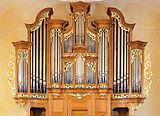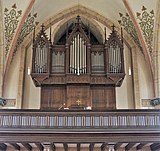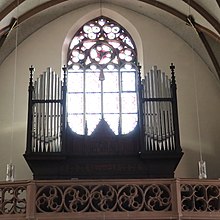Heinrich Voit
Heinrich Voit (born March 18, 1834 in Durlach ; † October 1914 there ) was a German organ builder and the best-known representative of the Voit family of organ builders. After him, the Durlach organ building company was called H. Voit & Sons from 1890 to 1932, when it was closed .
history
ancestors
The family business Voit originally came from Franconia . In Schweinfurt , according to old documents "since the middle of the 17th century, members of the family from sex to sex have been involved in organ building". Johann Volkmar Voit (* 1772; † 1806) had four brothers. Carl Friedrich Voit also built instruments and organs like his father and grandfather. Johann Volkmar Voit moved from Schweinfurt to Durlach (now part of Karlsruhe ), where he married Katherina Friederike Stein , the daughter of the Durlach organ and piano builder Georg Marcus Stein (* 1738; † 1794), and after the death of his father-in-law, in 1794 Company took over. After the early death of Johann Volkmar Voit, whom Elector Karl Friedrich had appointed Baden court organ maker in 1804, the widow married the journeyman organ maker Johann Ludwig Wilhelm Bürgy (* 1761; † 1838). He trained his stepson Louis Voit (* 1802; † 1883) to be an organ builder and made him his partner and successor in 1835.
Owner Heinrich Voit
In 1870, Louis' son Heinrich Voit became the managing director and from 1890 on, together with his sons Emil (* 1865; † 1924) and Siegfried (* 1870; † 1939) operated as H. Voit & Sons . Furthermore, the younger sons Heinrich Voit jun. (* 1871; † 1926) and Julius Voit (* 1883; † 1955) work in the family business.
The company flourished up to the First World War . In 1890 the first Voit organ with a pneumatic action falls . In Heinrich Voit's time in 1899, a very responsive pneumatic windchest system similar to the American Rooseveltlade was developed. In view of the sporadic disc shutters built by Voit from around 1885 , as preserved in the Bühl-Neusatz church , it must be questioned whether Voit was really based on the US model, as is claimed in the sparse literature. Since the disc drawer is, so to speak, a mechanical version of the pneumatic wind drawer system patented by Voit in 1899, it could very well have served as a model. The first attempts with an electric action took place in 1885 in the church of St. Barbara in Forst (Baden) . However, Voit has been purchasing electropneumatic actions from M. Welte & Söhne since at least 1887 ; the collaboration has not been researched.
In 1903 the world's first mobile electric organ console was built in Heidelberg. In the Evangelical City Church and the Church of St. Bernhard, both in Karlsruhe, high pressure registers were arranged.
A specialty of the company were generously built concert hall organs. In 1912 Voit delivered a three-manual organ with 50 stops to a music school in Paris.
Heinrich Voit also supplied various smaller organ builders in Baden with organ parts and pipes, for example his former apprentice Mathias Burkart (* 1838; † 1922) in Heidelberg -Kirchheim or Wilhelm Schwarz & Sohn in Überlingen .
Hans Voit (* 1904; † 1994), son of Heinrich Voit jun. , founded his own company in Stendal in 1930 .
Downfall of the company
The First World War weakened the company considerably. From 1914 until the end of the war, almost all workers were drafted, Carl Hess (* 1879; † 1943), long-time manager and voicer, ran the business together with Emil and Siegfried Voit in Durlach. Only a few of the experienced former employees returned home after the end of the war.
Many of the organ works built after 1918 already had serious technical defects when they were officially accepted. The Protestant organ building inspector Walter Leib , who worked for Baden, took the unsuccessful rebuilding of the organ in Mannheim-Feudenheim as an opportunity to publicly warn against the work of the Voit company.
Company task
Operations manager Carl Hess founded his own organ building company in Durlach in 1920 and systematically promoted the decline of his former employer. In the spring of 1932 Siegfried Voit gave up the company. The organ builders Reinhold Sauder (as voicer) and Wilhelm Wagner (as windchest carpenter), who had remained with Voit until then, went into business for themselves. The often-widespread comment that Hess set up in Voits workshops is, however, unfounded and unsustainable. As early as the 1930s, Carl Hess was building occasional grinding chests.
After the death of Carl Hess, the widow Anni Hess b. Meyer (* 1900; † 1981) continued the business until the beginning of 1961. Then the Hess company also went out.
List of works
| year | place | building | image | Manuals | register | Remarks |
|---|---|---|---|---|---|---|
| 1758/59 | Directions | St. Joseph | received technically modified | |||
| 1840 | Knittelsheim | St. George |

|
18th | received technically modified | |
| 1853 | Friedrichshof | St. Maria Rosenkoenig | I / P | 9 | restored by Vleugels in 1993 | |
| 1860 | Gerolzahn | Catholic St. Marien | I / P | 4th | restored by Vleugels in 1974 | |
| 1864 | Baden-Baden | Ev. City Church | II / P | 30th | not received | |
| 1867 | Baden-Baden | St. Boniface | received some registers | |||
| 1868 | Ladenburg | St. Gallus Church |

|
III / P | 41 | today Alexanderkirche Marbach → organ |
| 1869 | Weidenthal | Ev. Christ Church | II / P | 24 | preserved, restored in 1997 by Gerhard Kuhn, Esthal | |
| 1873 | Sinsheim -Hilsbach | Ev. church | II / P | 28 | receive | |
| 1875 | Heidelberg | Jesuit Church | many registers preserved in the Valley Organ Museum | |||
| 1877 | Mannheim | St. Sebastian |

|
III / P | 36 | Exhibited at the art and trade exhibition in Karlsruhe in 1875 and installed in St. Sebastian in 1877, partially preserved |
| 1878 | Distelhausen | St. Mark | II / P | 18th | restored by Vleugels 1971/88 | |
| 1879 | Weidenthal | St. Simon and Jude Thaddaeus | II / P | 24 | not preserved, replaced in 1972 | |
| 1879 | Gailingen on the Upper Rhine | Cath. St. Dionysius | II / P | 24 | former St. Blasien cathedral organ, moved in 1913, cleaning by Vleugels 2011 | |
| 1879 | Zweibrücken | Holy Cross Church |

|
II / P | 24 | Expanded to 43 registers in 1911, destroyed in 1945 |
| 1879 | Eppingen | Evangelical town church | II / P | 26th | receive | |
| 1880s | Lambrecht (Palatinate) | Catholic Church of St. Johannes Nepomuk (today Heart of Jesus) | not received; rebuilt and replaced in 1946, 1954 and 1972 | |||
| 1887 | Eschbach | Catholic St. Agnes | II / P | 16 | restored by Vleugels in 1993 | |
| 1888 | Hochstadt (Palatinate) | Prot. Church Niederhochstadt | Originally preserved except for the prospectus pipes | |||
| 1890 | Forbach (Baden) | St. Johannis | II / P | 30th | first organ Voits with pneumatic cone chests, canceled in 1965 | |
| 1891 | Kirrlach | Catholic Church | III / P | 35 | received changed | |
| 1892 | Schopfheim | Ev. (new) city church | II / P | 26th | preserved and restored | |
| 1892 | Jöhlingen | St. Martin | II / P | 18th | Preserved and restored in original condition except for prospectus pipes | |
| 1892 | Kembach | Ev. church | I / P | 10 | restored by Vleugels in 1979 | |
| 1893 | Otterbach | Assumption Day | z. T. received, expanded in 1989 | |||
| 1893 | Edingen-Neckarhausen | Ev. church | preserved, but stored, is to be transferred to the Trossingen University of Music | |||
| 1893 | Messelhausen | Catholic St. Burkhard | II / P | 14th | restored by Vleugels in 1981 | |
| 1894 | St. Ingbert | St. Joseph | III / P | 59 (52) | received greatly changed | |
| 1894 | Heckfeld | Catholic St. Vitus | I / P | 12 | restored by Vleugels in 1994 | |
| 1895/1896 | Durlach | Town church Durlach |

|
III / P | 41 | 5 registers received |
| 1894 | Dunzweiler | Evang. | I / P | 8th | Housing reused in a new building by Vleugels in 1995 | |
| 1896 | Karlsruhe | Grand Ducal Baden grave chapel | received, but z. Currently unplayable | |||
| 1898 | Munsterappel | Monastery church |

|
|||
| 1900 | Bischweier | Catholic Church | In 1960 it was replaced by a new building in which parts have been preserved and changed | |||
| 1900 | Dirmstein | Laurentiuskirche , catholic part |

|
III / P | 23 | technically modified 1986, preserved |
| 1900 | Erlenbach near Dahn | Saint Mary of the Assumption and Aegidius | I / P | 6th | preserved, restored by Peter Ohlert (Kirkel) | |
| 1900 | trier | Treveris Festival Hall | II / P | 32 | First Voits concert organ, moved to the gallery in 1946, given away to Mückeln before the building was demolished in 1974 , where it has been partially preserved | |
| 1902 | Gillenfeld-Eifel | Catholic St. Andreas | II / P | 17th | Partial reconstruction by Vleugels 2016 | |
| 1902 | Nunkirchen | Sacred Heart Church | II / P | 26th | Dismantled in 1917, rebuilt in 1920, largely preserved, expanded to 30 registers in 1980 by Hugo Mayer Orgelbau | |
| 1902 | Heppenheim-Hambach | Parish and pilgrimage church of St. Michael | I / P | 11 | Almost unchanged, restored in 1987. | |
| 1903 | Heidelberg | City Hall |

|
III / P | 56 | restored by Vleugels in 1993 |
| 1903 | Mannheim | Muses room in the rose garden | not received | |||
| 1903 | Pfaffenthal | Église Saint-Mathieu |

|
II / P | 25th | 1968 major overhaul by the Manufacture d'orgues luxembourgeoise Georg Westenfelder Lintgen . The pneumatic action was converted electropneumatically, the organ got a new console, the pipework remained untouched. |
| 1904 | Vineyard | Catholic St. Michael | I / P | 23 | Housing used by Vleugels in the new building in 1981 | |
| 1904 | Asbach | Catholic St. Mariae unfilled conception | II / P | 11 | restored by Vleugels in 2009 | |
| 1905 | Karlsruhe | St. Bernhard | with three high pressure registers; not received | |||
| 1905 | Baden-Baden | Collegiate church | III / P | 43 | received some registers | |
| 1906 | Karlsruhe | St. Cyriac | in a Silbermann case from Baden-Baden; receive | |||
| 1907 | Karlsruhe | Luther Church | not received | |||
| 1907 | Mannheim | Luther Church |

|
III / P | 40 | receive |
| 1907 | Lichtental (Baden-Baden) | Luther Church | II / P | Canceled in 1976 | ||
| 1907 | Budapest | Kgl. Ung. State Music Academy Franz Liszt | Prospectus received, reconstruction of the organ planned | |||
| 1907 | Russian | St Paul of the Cross Cathedral |

|
receive | ||
| 1908 | Karlsruhe | St. Boniface | seriously rebuilt by Hess in 1950 and Bormann in 1979, remains have been preserved | |||
| 1910 | Hoepfingen | St. Aegidius | II / P | 23 | Housing used by Vleugels in the new building in 1982 | |
| 1910 | Düsseldorf - Pempelfort | Kreuzkirche | III / P | 44 | not preserved, replaced in 1966 by a new building by Alexander Schuke, Potsdam (III + P / 45) | |
| 1912 | Baden-Baden | Hofgut Maria Halden | House organ with organola; receive | |||
| 1912 | Prague | Smetana Hall | III / P | 70 | preserved, restored by Vleugels in 1997 | |
| 1913 | Mannheim | Castle Church | not received | |||
| 1913 | Rotenberg (Rauenberg) | St. Nicholas | not received | |||
| 1915 | Karlsruhe | Concert hall | not received | |||
| 1915 | Woellstein | Cath. | II / P | 15th | Partial restoration by Vleugels in 1998 | |
| 1916 | Baden-Baden | Kurhaus | currently stored at Vleugels | |||
| 1917 | Krefeld | City Hall | not received | |||
| 1921 | Baden-Baden | St. Bernhard | III / P | 47 | received greatly changed | |
| ? | Baden-Baden | Dreieichenkapelle | destroyed by fire in 1979 |
literature
- Markus Zepp: "... a masterpiece from the well-known H. Voit & Sons organ factory in Durlach ..." The history of the Voit organ in the Kurhaus Baden-Baden . In: Ioculator Dei. Festschrift for Andreas Schröder on the occasion of his 60th birthday . Freiburg 1999.
- Evangelical Oberlandeskirchenarchiv Karlsruhe, Organ & Bell Examination Office: files of organ builder recommendations ,
- Gerhard Wagner ao: The Voit organ in the Heidelberg city hall, organ restoration - a contribution to cultural history . Heidelberg 1993, ISBN 978-3-924973-59-9 .
- Estate of the Archbishop's organ inspector Otto Schäfer (1876–1967), Baden-Baden (private property).
Web links
Individual evidence
- ↑ Friedrich Blume, Ludwig Finscher: Music in the past and present . General Encyclopedia of Music, Part 2 . Issue 2nd volume 17 . Bärenreuter, 2007, ISBN 3-7618-1137-3 , p. 197 f .
- ↑ Gerhard Wagner among others: The Voit organ in the Heidelberg city hall. Organ restoration - a contribution to cultural history. Heidelberg 1993.
- ↑ M. Welte & Sons .
- ^ Franz Bösken , Hermann Fischer , Matthias Thömmes: Sources and research on the organ history of the Middle Rhine (= contributions to the Middle Rhine music history . Volume 40 ). tape 4 : Koblenz and Trier administrative districts, Altenkirchen and Neuwied districts . Schott, Mainz 2005, ISBN 978-3-7957-1342-3 , pp. 1144 f .
- ^ Festschrift for the organ consecration on March 13, 2016.
- ^ Oskar Gottlieb Blarr, Theodor Kersken: Orgelstadt Düsseldorf. Düsseldorf 1982, p. 68 f., Ill. P. 66 f.
| personal data | |
|---|---|
| SURNAME | Voit, Heinrich |
| BRIEF DESCRIPTION | German organ builder |
| DATE OF BIRTH | March 18, 1834 |
| PLACE OF BIRTH | Durlach |
| DATE OF DEATH | October 1914 |
| Place of death | Durlach |




